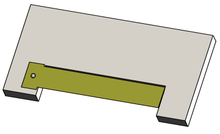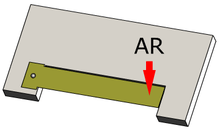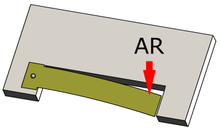Free reed aerophone

A free reed aerophone is a musical instrument that produces sound as air flows past a vibrating reed in a frame. Air pressure is typically generated by breath or with a bellows.
Operation
The following illustrations depict the type of reed typical of harmonicas, pitch pipes, accordions, and reed organs as it goes through a cycle of vibration. One side of the reed frame is omitted from the images for clarity; in reality, the frame completely encloses the reed. Airflow over one side of the reed creates an area of low pressure on that side (see the Bernoulli's principle article for details), causing the reed to flex towards the low-pressure side. The reed frame is constructed so that the flexing of the reed obstructs the airflow, which reduces or eliminates the low pressure area and allows the reed to flex back.[1]
 |
A reed is fixed by one end in a close-fitting frame. The loose end has a slight rising bend. |
 |
Air depression is applied under the reed; the reed prevents air flow, except for a small, high-velocity flow at the tip. |
 |
The reed is sucked through the opening, allowing the air to pass. |
 |
The elasticity of the reed forces it back through the frame. |
Each time the reed passes through the frame, it interrupts air flow. These rapid, periodic interruptions of the air flow create the audible vibrations perceived by the listener.
In a free-reed instrument, it is generally the physical characteristics of the reed itself, such as mass, length, cross-sectional area, and stiffness, which determine the pitch (frequency) of the musical note produced. Of secondary importance to the pitch are the physical dimensions of the chamber in which the reed is fitted, and of the air flow. As an exception, the pitch of the Chinese bawu and hulusi are determined by fingering recorder-like tone holes along the instrument body.
History
.jpg)
Various free reed instruments appear to have been invented since antiquity, but were unknown in the West until the early modern period. The most likely precursor to free reed aerophones is the Jew's harp,[2] an instrument known to many cultures throughout the world, and by many names (e.g., k'uang in ancient China[3]). In this instrument, the main sound producer is the vibrating reed tongue itself, rather than the air flow.
Among the ancient instruments, the khene of Laos, the shēng of China and the shō of Japan have survived to modern times.
The sheng was traditionally made with bamboo pipes, and was first mentioned in the Shi Jing of the Zhou Dynasty (c. 1050–256 BC). The Chinese sheng is considered the ancestor of the harmonica, harmonium, concertina, accordion, and all other reed organ instruments. A free reed organ was invented in the Arab world in the 13th century, while the German Heinrich Traxdorf (fl. 15th century) of Nuremberg built one around 1460 AD. It is thought that the classical Chinese sheng traveled west through Russia during the 19th century, as it was described then in Saint Petersburg.[4] It has been claimed that this inspired a series of inventions in the early 19th century that were the foundation of the development of the modern free reeds.
At Copenhagen, one of these instruments with brass pipes and free reeds in-caved into the sides of this pips inspired the organ builder Mr. Kirsnick to fit similar reeds into portable organs.[5] 1880 Kirsnick moved to Saint Petersburg improved this new organ pipes to adjustable pitch with a hook. Christian Gottlieb Kratzenstein built also his speaking machine in Copenhagen and he was in contact with Mr. Kirsnick. Christian Gottlieb Kratzenstein got an award for the machine in Petersburg but he never moved to Petersburg. His machine or a copy of this machine came to Paris very shortly after 1880. Georg Joseph Vogler put all his effort to get this new type of organ pipes in use in church organs so he started with changing organs in Rotterdam (1790), London(1790),[notes 1] Frankfurt (1791), Stockholm (1791), Paris (1796), Berlin (1800), Prague (1802), Vienna (1804), Salzburg Munich (1805), – up to 30 documented rebuilds of organs with new free reed type organ pipes. He also held lessons at universities and did all to promote this new type of reeds, not only in German-speaking regions of Europe. The actual work was done by different organ builders, and very many people ware involved, so it is nearly impossible that any organ builder in Europe did not know about free reeds after 1800. In the two years from 1802 to 1804 in Vienna, he spent time with Johann Nepomuk Mälzel and Mälzel changed the type of reeds used in his Panharmonicon to free reed pipes. Vogler, Maelzel and Friedrich Kaufmann were then at the same time in Paris in 1807. From there, Mälzel went to Regensburg and Vienna, where he constructed a new Panharmonicon and the mechaischer Trompeter; after that he went on tour again to Paris, London and other places; maybe he went for the first time to Boston and New York as well, but up to now we don't know of any notice in a newspaper about it. Friedrich Kaufmann, a clock maker, went back home to Dresden and copped Mälzel's machines. The mechaischer Trompeter still can be seen in a museum in Munich.
First use in America
In the United States, organ builder William M. Goodrich is often claimed to have invented the free reed. He tells that he worked in 1810 to 1812 with Johann Nepomuk Mälzel's Pan Harmonicon that was sent to Boston and then exhibited in several towns. Märzel had a very good relationship to Vogler while in Europe so his Pan Harmonicon used free reeds. It is not known with certainty whether Mälzel was personally in America around 1811. What is clear is that he arrived New York on February 7, 1826, which might have been either his first or his second visit to the New World. He also visited Boston around that time.
"In June 1811 a curious instrument called a Pan Harmonicon was brought to Boston. It was invented by Maelzel, whose name is usually linked with the Metronome. William Goodrich was employed to set up and exhibit the Pan Harmonnicon in New York and other cities. He […] traveled with the instrument from September 1811 until June 1812."[6]
1823 Pan Harmonicun copied;
In March, 1823, Mr. Goodrich undertook to complete, with the assistance of others, a Pan Harmonicon, in imitation of that of Maelzel. Mr. Savage, the proprietor of a Museum in Boylston Hall, had kept the latter for some time on exhibition in his Museum, and had made considerable progress in constructing one like it. After his death, it was determined to complete it. Mr. Goodrich was employed, and it was finished in May, 1824. From November, 1824, till sometime in 1825, he was chiefly employed in the exhibition of this instrument;[7]
There is a story that in 1821 James H. Bazin repaired a free reed pipe and used this type of reeds for constructing, in 1836, the "lap organ".
In an article in " The Musical World and Times " […] the invention of this class of instruments is claimed for Mr. James H. Bazin, an ingenious musician and mechanic, of Canton, Mass. […] However,[…] as will be observed […] Mr. Bazin was not the man. The account referred to contains the following :— " Late in the year of 1821, some young men from a neighboring town, brought a small, round, brass pipe, with the letter A marked on it, and a piece of thin brass screwed on one side; which brass appeared to have been made to vibrate through an opening about one-half the length of the pipe, but which had been broken off near the screw. They had borrowed this pipe from a singing-master in Boston, and wished to have Mr. Bazin repair it, […] We have a legend, in which it is asserted that the free reed was the invention of a German shoemaker [Maelzel], who, captivated with the sweet sounds produced by it,[…],[8][9]
From 1833, Prescott built similar instruments.
In 1831 Prescott […]. On a business trip to Boston he saw an "elbow organ" or lap organ ("rocking melodeon") built by Jams Bazin. Seeing the potential of this small REED ORGAN, he commenced manufacturing them in 1836 or 1837 – both the button (melodeon) and the conventional keyboard type;[10][11]Video of "rocking melodeon" [12]
Melodeons in 1840
By 1840, there were 40 melodeon builders in America.
"Melodeons were inexpensive, easy to move, and required a minimum of upkeep. These features were so attractive that by 1840 there were forty melodeon builders in the United States, with an annual product of $646,975, but reports listed only twenty pipe organ builders, with an annual product of $324,750 [13,p.132]"[13]
Europe
Cyrill Demian's (see below) patent of 1829 [14] however states that the reeds in his instrument "were known for more than 200 years as Regale, Zungen, Schnarrwerk, in organs." He compares the reeds used by him with beating reeds.
The accordion in Russia
The earliest history of the accordion in Russia is poorly documented. Nevertheless, according to Russian researchers, the earliest known simple accordions were made in Tula, Russia by Timofey Vorontsov from 1820, and Ivan Sizov from 1830.[15] By the late 1840s, the instrument was already very widespread;[16] together the factories of the two masters were producing 10,000 instruments a year. By 1866, over 50,000 instruments were being produced yearly by Tula and neighbouring villages, and by 1874 the yearly production rate was over 700,000.[17] By the 1860s, Novgorod, Vyatka and Saratov Governorates also had significant accordion production. By the 1880s, the list included Oryol, Ryazan, Moscow, Tver, Vologda, Kostroma, Nizhny Novgorod, Simbirsk and others, and many of these places created their own varieties of the instrument.[18] The first chromatic piano-like accordions in Russia were built in 1871 by Nikolay Ivanovich Beloborodov.[19]
In 1907, St. Petersburg master accordion maker V. S. Sterlingov created a chromatic button accordion for the player Ya. F. Orlandskiy-Titarenko featuring 52 melody keys and 72 chords of the Stradella bass system. Orlandskiy-Titarenko called his new instrument the bayan (after the legendary bard Boyan), and it was the ancestor of the modern instrument with that name. However, its layout on the melody side was different from the layout of the modern bayan. The modern bayan's B-system layout (or "Moscow system") became more popular than the early instrument's "Leningrad system" (which was more similar to the Khromka garmon) around 1930–35.[20]
Between 1953 and 1968, the yearly production of button accordions (garmons and bayans) in the Soviet Union ranged between 597,307 and 921,674 instruments, while the yearly production of piano accordions ranged between 7,124 and 120,313 instruments (averaging around 50,000).[21]
Some notable free reed instruments
- The Chinese hulusi, bawu and sheng
- Querhammerflügel with Aeoline, circa 1810, made by Johann Kasper Schlimbach at Königshofen Bayern, using steel reeds and frames made in one part.
- The accordion, patented in 1829 by Cyrill Demian.
- The concertina, patented in two forms (perhaps independently):
- Sir Charles Wheatstone, 1829 and 1844.
- Carl Friedrich Uhlig, 1834.
Other examples
Related instruments
In the related woodwind instruments, a vibrating reed is used to set a column of air in vibration within the instrument. In such instruments, the pitch is primarily determined by the effective length of that column of air. Although the Chinese sheng, Japanese sho and Laotian khene have pipes, the pipes do not determine the pitch. In these instruments, the pipes serve as resonating chambers.
Notes
- ↑ He was in London 1890 and recorded this in his autobiography, but it is unclear whether this was after or before his visit to Warschau in the same year. It is also unclear if he did make changes to church organs there. His Orchestrion that he was carrying with him was not using free reeds at this time.
References
- ↑ John Watkinson (1998), The Art of Sound Reproduction, Focal Press, p. 117, ISBN 978-0-240-51512-0.
- ↑ Crane, Frederick (1 January 1968). "The Jew's Harp as Aerophone". The Galpin Society Journal. 21: 66–69. doi:10.2307/841429. JSTOR 841429 – via JSTOR.
- ↑ Picken, Laurence (1 January 1962). "Musical Terms in a Chinese Dictionary of the First Century". Journal of the International Folk Music Council. 14: 40–43. doi:10.2307/835557. JSTOR 835557 – via JSTOR.
- ↑ Needham, Joseph (1962). Science and Civilization in China: Volume 4, Physics and Physical Technology; Part 1, Physics. Cambridge University Press., reprinted Taipei: Caves Books, Ltd.(1986). pp. 211–212.
- ↑ Allgemeine musikalische Zeitung, 5 March 1823. Nr. 10, Vol. 15, pg. 149–155. (online)
- ↑ The History of the Organ in the United States, Orpha Caroline Ochse, page 77 Online
- ↑ The New-England Magazine, Band 6, page 32 Online
- ↑ Emerson's magazine and Putnam's monthly, Band 2 1855, Page 117,Online
- ↑ The New-England Magazine, Band 6, von 1834, Page 25 – 45 Online
- ↑ The organ: an encyclopedia, off Richard Kassel, Page 441,Online
- ↑ The organ in Manitoba: a history of the instruments, the builders and the …, James Barclay Hartman, Page 16 Online
- ↑ SilverStringsClub (16 August 2009). "Oh Suzannah – Silver Strings Variety Night – July 2009" – via YouTube.
- ↑ The History of the Organ in the United States, Orpha Caroline Ochse, Page 112,Online
- ↑ See "Demian's Accordion Patent translated from archaic German by Karl and Martin Weyde" at http://www.ksanti.net/free-reed/history/demian.html
- ↑ Mirek, Alfred. Garmonika. Proshloe i nastoiashchee. Nauchno-istoricheskaia entsyklopedicheskaia kniga. Moscow, 1994. p.50
- ↑ Etnograficheskii sbornik Russkogo geograficheskogo obshchestva. Vol.2, Saint Petersburg, 1854. p.26, 162.
- ↑ Mirek, Alfred. Iz istorii akkordeona i baiana. Moscow, 1967. p.43-45
- ↑ Banin A.A. Russkaia instrumentalnaia muzyka folklornoi traditsii. Moscow, 1997. (p.144)
- ↑ Fadeyev, I.G. and I.A. Kuznetsov. Remont garmonik, bayanov, i akkordeonov. Izdaniye 2-e, ispravlennoye i dopolnenoye. Moscow: Legkaya industriya, 1971. p.9-10.
- ↑ Fadeyev, 12-13.
- ↑ Fadeyev, 15.
External links
- What Is A Free Reed?
- The Classical Free Reed, Inc. website
- Reeds World Musical Instrument Gallery
- The Roots of Reeds – an exhibition curated by the Museum of Making Music, Carlsbad, CA – detailing the history and migration of reed instruments.
 Chisholm, Hugh, ed. (1911). "Free reed vibrator". Encyclopædia Britannica (11th ed.). Cambridge University Press.
Chisholm, Hugh, ed. (1911). "Free reed vibrator". Encyclopædia Britannica (11th ed.). Cambridge University Press.